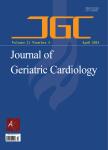Influence of increased epicardial adipose tissue volume on 1-year in-stent restenosis in patients who received coronary stent implantation
Influence of increased epicardial adipose tissue volume on 1-year in-stent restenosis in patients who received coronary stent implantation作者机构:Department of Cardiology Chinese PLA General Hospital Beijing China VIP Medical Service Department Beijing SHIJITAN Hospital Belling China Department of Cardiology Chinese PLA 175 Hospital Fujian China School of Medicine Nankai University Tianjin China Department of Cardiology Tianjin Chest Hospital Tianjin China
出 版 物:《Journal of Geriatric Cardiology》 (老年心脏病学杂志(英文版))
年 卷 期:2016年第13卷第9期
页 面:768-775页
核心收录:
主 题:Computed tomography Drug-eluting stents Epicardial adipose tissue In-stem restenosis
摘 要:Background Epicardial adipose tissue (EAT) is significantly associated with the formation and composition of coronary atherosclerotic plaque, cardiac events and the clinical prognosis of coronary heart disease. But, whether increased EAT deposition may affect the incidence of in-stent restenosis (ISR) is currently unclear. This study used coronary computed tomography angiography (CCTA) as a mean to investigate whether increased EAT volume was associated with ISR. Methods A total of 364 patients who underwent 64-slice CCTA examination for the evaluation of suspected coronary artery disease, and subsequently underwent percutaneous coronary intervention (PCI) for the first time, and then accepted coronary angiography (CA) follow-up for ISR examination in one year, were retrospectively included in this study. EAT volume was measured by CCTA examination. CA follow-up was obtained between 9 and 15 months. ISR was defined as 〉 50% kuninal diameter narrowing of the stent segment or peri-stent segment. EAT volume was compared between patients with and without ISR and additional well-known predictors of ISR were compared. Results EAT volume was significantly increased in patients with ISR compared with those without ISR (154.5 ± 74.6 mL vs. 131.0 ± 52.2 mL, P 〈 0.001). The relation between ISR and EAT volume remained significant after adjustment for conventional cardiovascular risk factors and angiographic parameters. Conclusions EAT volume was related with ISR and may provide additional information for future ISR.



